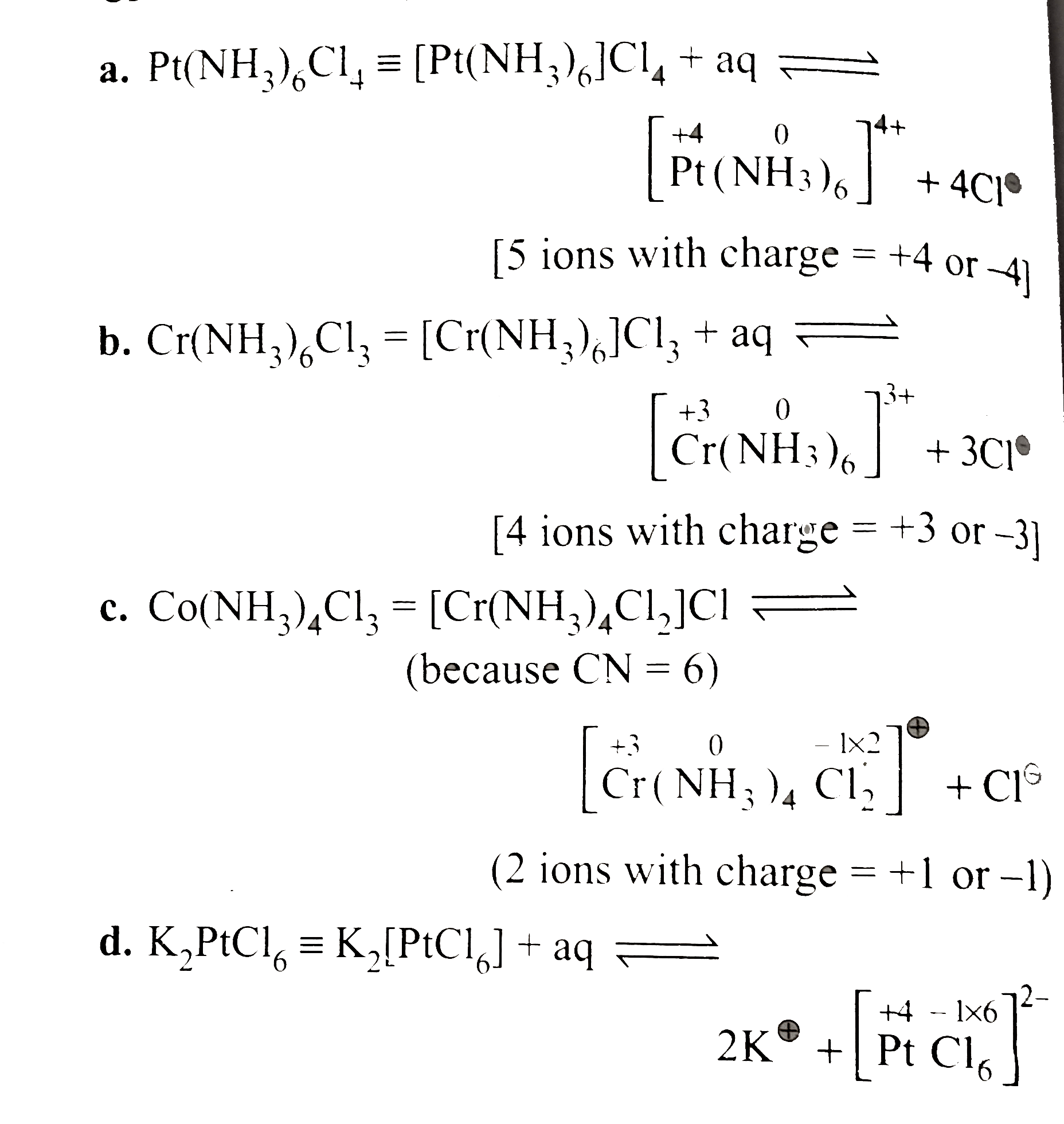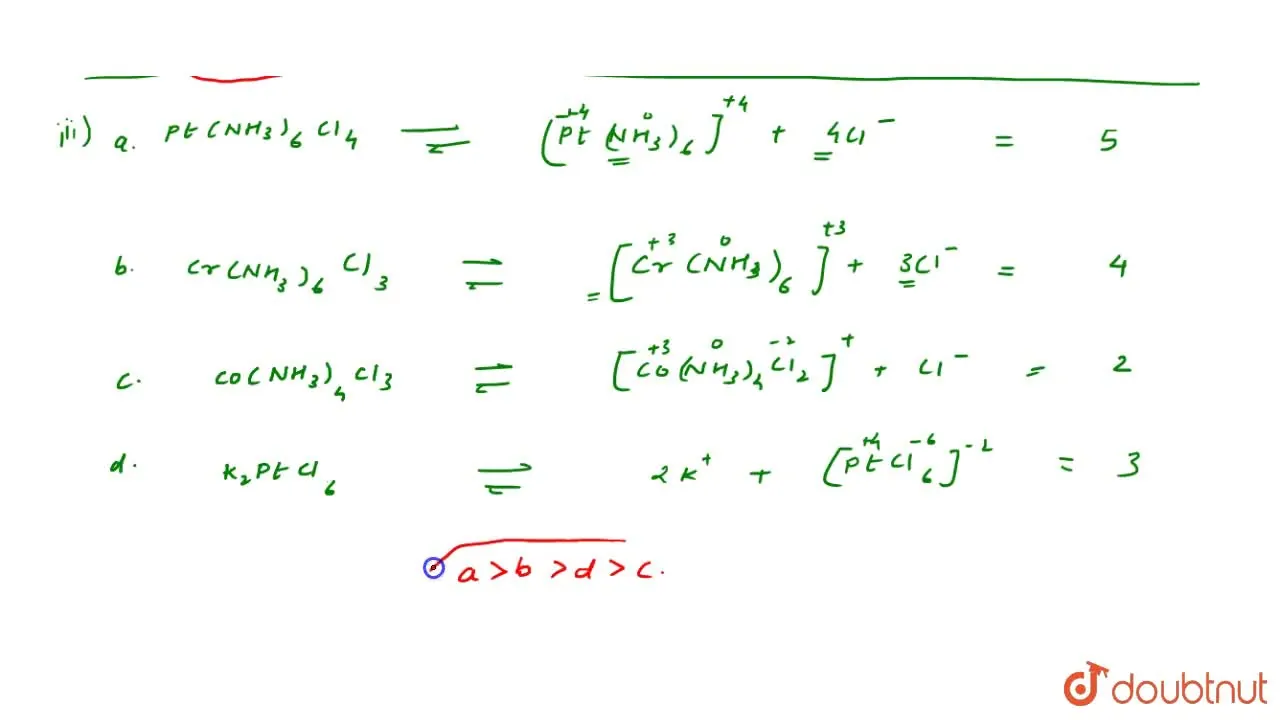Arrange the following compounds in the order of decreasing molar conductivity in aqueous solution.
i.a.K[Co(NH3)2(NO2)4]
b.[Cr(NH3)3(NO2)3]
c. [Cr(NH3)5(NO2)]3[Co(NO2)6]2
d. [Mg(Cr(NH3(NO2)5]
ii.a.Li[Co(NH3)2(NO2)4] b. Na[Co(NH3)2(NO2)4]
c.K[Co(NH3)2(NO2)4] d. Cs[Co(NH3)2(NO2)4]
iii.a.Pt(NH3)6Cl4b. Cr(NH3)6Cl3
c. Co(NH3)4Cl3 d.K2PtCl6
Conductance or conductivity in an aqueous solution depedns on :
Greater the number of ions in solution, more is the conductance.
For same number of ions, greater the charge on the ion, more is the conductance.
If the number of ions and charge on the ions are equal, then conductance is inversely proportional to its size in the aqueous solution.
For example, the size of Cs⊕>Rb⊕>K⊕>Na⊕>Li⊕. Thus, smallest ion should move more rapidly, however, ionic mobility shows the reverse trend because smaller ions are more extensively hydrated ( due to high charge densit) and thus hydrated ion size for these ions is :
Li⊕(aq)>Na⊕(aq)>K⊕(aq)>Rb⊕(aq)>Cs⊕(aq)

( Two ions with charge +1 or −1)

No ionization ( no ions with zero charge )
( Five ions with charge =+6 or −6)
[ Two ions with charge =+2 or −2]
So the decreasing order of conductance is :
c>d>a>b
ii. Since the anion part is same in all the coordination compounds and the number of ions produced in solution (2 ions ) and charge (+1or −1) is also same, so the conductance will depend on the size of the ions in aqueous medium and inversely proportional to its size.
So, the size of these ions in aqueous solution is
Li⊕(aq)>Na⊕(aq)>K⊕(aq)>Cs⊕(aq)
and conductance is reversed.
∴ Decreasing order of conductance is
d>c>b>a
iii. In this question, first write these compounds in the form of coordination compounds, knowing their coordination number. For example ,
CN for Pt4+,Cr3+,Co3+=6
So decreasing order of conductance is :
a>b>d>c
Related Playlists
- BOOK - CENGAGE CHEMISTRYCHAPTER - ELECTROCHEMISTRYEXERCISE - Solved Examples (Electrochemical Cell)36videos
ELECTROCHEMISTRY
- BOOK - CENGAGE CHEMISTRYCHAPTER - ELECTROCHEMISTRYEXERCISE - Solved Examples(Electrolysis And Electrolytic Cells)12videos
ELECTROCHEMISTRY
- BOOK - CENGAGE CHEMISTRYCHAPTER - D AND F BLOCK ELEMENTSEXERCISE - Archives Subjective29videos
D AND F BLOCK ELEMENTS
- BOOK - CENGAGE CHEMISTRYCHAPTER - GENERAL PRINCIPLES AND PROCESS OF ISOLATION OF ELEMENTSEXERCISE - Archives (Subjective)14videos
GENERAL PRINCIPLES AND PROCESS OF ISOLATION OF ELEMENTS
Similar Questions
Arrange the following compounds in order of increasing molar conductivity .
(i)K[Co(NH3)2(NO2)4] (ii)[Cr(NH3)3(NO2)3]
(iii)[Cr(NH3)5(NO2)]3[Co(NO2)6]2 (iv)[Cr(NH3)6]Cl3View SolutionArrange the following compounds in order of increasing molar conductivity
(a) K[Co(NH3)2(NO2_(4)]
(b) [Cr(NH3)3(NO2)3]
(c) [Cr(NH3)5(NO2)]3[Co(NO2)6]2
(d) Mg[Cr(NH3)(NO2)5]View Solution[Co(NH3)4(NO2)2]Cl exhibits.
View Solution[Co(NH3)4(NO2)2]CI exhibits
View Solution[Co(NH3)4(NO2)2]CI exhibits
View Solution[Co(NH3)5NO2]SO4 shows
View Solution[Co(NH3)4(NO2)2]CI exhibits
View SolutionArrange the following compounds in order of increasing molar conductivity
(a) K[Co(NH3)2(NO2)4]
(b) [Cr(NH3)3(NO2)3]
(c) [Cr(NH3)5(NO2)]3[Co(NO2)6]2
(d) Mg[Cr(NH3)(NO2)5]View SolutionIUPAC name [Co(NH3)5(NO2)]Cl2 is
View SolutionArrange the following complexes in the increasing order of conductivity of their solution
[Co(NH3)3Cl3],[Co(NH3)4Cl2]Cl,[Co(NH3)6]Cl3,[Cr(NH3)5Cl]Cl2View Solution


